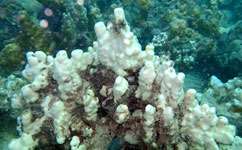Scientists link nutrient pollution to coral bleaching

Too many nutrients can put corals at risk, a new study shows. Excessive nitrogen in the water affects their ability to cope with rising water temperatures and other environmental pressures, making them vulnerable to harmful bleaching.
That is, an excessive supply of nutrients can paradoxically lead to nutrient starvation. It does this by over-fertilizing the symbiotic algae on which corals depend, making them grow more quickly than the more limited supply of phosphorus can support. This unbalanced growth makes them more susceptible to stress.
The discovery may point towards ways we can help protect coral reefs, safeguarding these uniquely rich habitats as well as the livelihoods of the millions of people who depend on them. It's the latest in a long list of reasons to control nitrogen pollution, which has also catastrophic effects on river ecosystems and causes harmful algal blooms in coastal waters.
Bleaching is when corals lose their populations of cooperative algae, indicated by their brown colours fading to white, and it's one of the greatest threats to coral reefs worldwide.
It's generally agreed to be caused primarily by higher seawater temperatures, which put the corals under stress by disrupting their algae's ability to photosynthesise. In mild cases the corals can recover; in severe ones, whole reefs can bleach and die.
Scientists already knew that nutrient pollution could make the situation worse. Some of the worst bleaching in areas like the reefs off Florida or around Australia's Great Barrier Reef happens in areas of high nitrogen levels, often caused by fertilizers running off farmland. But this is the first time anyone's identified a mechanism by which the nutrients contribute to bleaching.
'More nitrogen in the water can cause biochemical changes in the cell membranes of the algae that ultimately lead to a lower thermal threshold for bleaching - it means the corals can bleach at a lower temperature,' says Dr Jörg Wiedenmann, a senior lecturer in biological oceanography at the University of Southampton and lead author of the paper, which appears in Nature Climate Change. He is also head of the Coral Reef Laboratory at the NERC-funded National Oceanography Centre.
Corals are symbiont organisms – a cooperation for mutual benefit between two very different species. In this case, the partners are the coral animal, which builds the stony skeletons that we think of as coral, and a population of specialised algae known as zooxanthellae.
These tiny plants live inside the coral tissue that covers the skeleton, getting protection and certain vital nutrients in exchange for providing the coral animals with large amounts of the carbon compounds they produce through photosynthesis. Bleaching represents a breakdown in this symbiosis, in which the beneficial algae die off or are lost, leaving the coral animals vulnerable or even unable to survive.
Wiedenmann's team studied corals in large experimental aquariums, varied nitrogen levels, light intensity and temperatures, and then monitored how the corals responded. They found that high levels of dissolved nitrogen compounds did indeed make corals more likely to bleach when faced with high temperatures, and that this happens quickly - the effects could be seen within five to six weeks.
What seems to be happening is that the nitrogen stimulates fast growth in the zooxanthellae, causing them to use up their limited supply of phosphorus very quickly and then start to redistribute their phosphorus reserves, changing their chemical composition.
'Our results have strong implications for coastal management,' says Wiedenmann. 'They suggest that a balanced reduction of the nutrient input in coastal waters could help to mitigate the effects of increasing seawater temperatures on coral reefs. However, such measures will be effective only for a short period of time, so it is important to stop the warming of the oceans, which will otherwise destroy most of the reefs in their present form in the near future.'
He has just received a €1.3 million grant from the European Research Council within the Starting Grant Scheme to explore this area further, identifying more precisely how the algae respond to different levels of nutrient pollution and how much they can cope with. Wiedenmann says that even within the same coral species, different corals vary in the algae they hold, and that it's possible some algae can stand up to over-fertilisation better than others. This may explain the strangely patchy nature of coral bleaching – one group of corals in a reef may die off entirely, while superficially similar corals next door are scarcely affected.
Journal information: Nature Climate Change
Provided by PlanetEarth Online
This story is republished courtesy of Planet Earth online, a free, companion website to the award-winning magazine Planet Earth published and funded by the Natural Environment Research Council (NERC).


















